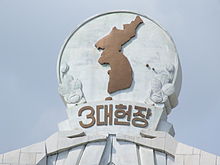You can help expand this article with text translated from the corresponding article in Korean. (June 2022) Click for important translation instructions.
|
| July 4 South–North Joint Statement | |
| Hangul | 7·4 남북 공동 성명 |
|---|---|
| Hanja | 7·4 南北 共同 聲明 |
| Revised Romanization | Chilsa Nambuk Gongdong Seongmyeong |
| McCune–Reischauer | Ch'ilsa Nambuk Kongdong Sŏngmyŏng |
The July 4 South–North Joint Statement, also known as the July 4 South–North Joint Communiqué, was the first joint statement by the governments of South Korea and North Korea, signed on July 4, 1972. The signatories of the statement were Lee Hu-rak and Kim Yong-ju, who represented the delegations from the south and north, respectively.
Pre-statement meetings
On May 2, 1972, South Korean president Park Chung Hee sent Lee Hu-rak, the then-director of the Korean Central Intelligence Agency (KCIA), to Pyongyang to meet and discuss the prospects of improving inter-Korean relations and Korean reunification with North Korean premier Kim Il Sung. However, the North Korean delegation was represented by Kim Yong-ju, the director of North Korea's Organization and Guidance Department and Kim Il Sung's younger brother, instead of Kim Il Sung. The two delegations, headed by Lee and Kim, held talks over the course of four days, from May 2 to 5, 1972. North Korean Vice Premier Pak Song-chol, acting on behalf of Kim Yong-ju, later visited Seoul and held further talks with Lee Hu-rak from May 29 to June 1, 1972. A joint statement by the governments of the two Koreas was subsequently finalized on July 4, 1972.
Three Principles of National Reunification

The Three Principles of National Reunification (3대헌장) were proposed by General Secretary Kim Il Sung of North Korea in 1972 and can be summarised as achieving reunification independently, unitedly, and peacefully. They comprised the following points;
1) First, national reunification should be achieved independently without reliance on outside forces and free from their interference.
2) Secondly, great national unity should be promoted by transcending the differences in ideas, deals and systems.
3) Thirdly, national reunification should be achieved by peaceful means without resorting to arms.
The emblem of the Three Charters; the Three Principles of National Reunification was located on the Arch of Reunification located on the highway between Pyongyang and Kaesong.
The declared goals of the statement were "to remove the misunderstandings and mistrust, and mitigate heightened tensions ... between the South and North", and "to expedite unification".
See also
References
- Moon Jae-in (January 3, 2022). "2022 New Year's Address by President Moon Jae-in". Embassy of the Republic of Korea in the USA.
- Yang, Moo-jin (December 21, 2020). "Why leaflets should stop". The Korea Times. Retrieved June 1, 2022.
- Yang, Jung-ah (May 9, 2008). "Minister Kim Ha Joong: "We Are Waiting for a Request for Food from North Korea"". Daily NK. Retrieved June 1, 2022.
- ^ Lee Hu-rak; Kim Young-joo (July 4, 1972). "The July 4 South-North Joint Communiqué" (PDF). Ministry of Unification of the Republic of Korea. United Nations Peacemaker.
- Kim, Dong Jin (September 21, 2018). The Korean Peace Process and Civil Society: Towards Strategic Peacebuilding. Berlin: Springer. p. 89. ISBN 978-3-319-97100-1.
- Byeong-cheon, Lee (2006). Developmental Dictatorship and the Park Chung-hee Era: The Shaping of Modernity in the Republic of Korea. Paramus, New Jersey: Homa & Sekey Books. p. 239. ISBN 978-1-931907-35-4.
- Limyingcharoen, Budsayapan (December 2019). "The Role of South Korea in Nuclear Crisis on the Korean Peninsula in 2000–2018". Thai Journal of East Asian Studies. 23 (2): 294–311.
- "Three Principles of National Reunification" (PDF). Korean Friendship Association.
- "Korea is One: Three Principles for National Reunification". Kim Il Sung - Kim Jong Il Foundation. Members of the Kim Il Sung - Kim Jong Il Foundation in Europe. September 19, 2020. Retrieved January 16, 2024.
Further reading
- Dong, Wonmo (2000). The Two Koreas and the United States: Issues of Peace, Security, and Economic Cooperation. Armonk, New York: M.E. Sharpe. ISBN 978-0-7656-0534-4.
- Radchenko, Sergey; Schaefer, Bernd (July 3, 2017). "'Red on White': Kim Il Sung, Park Chung Hee, and the Failure of Korea's Reunification, 1971–1973". Cold War History. 17 (3): 259–277. doi:10.1080/14682745.2016.1265508. ISSN 1468-2745. S2CID 157862693.
External links
- "The July 4 South-North Joint Communiqué" (in English)
This Korea-related article is a stub. You can help Misplaced Pages by expanding it. |